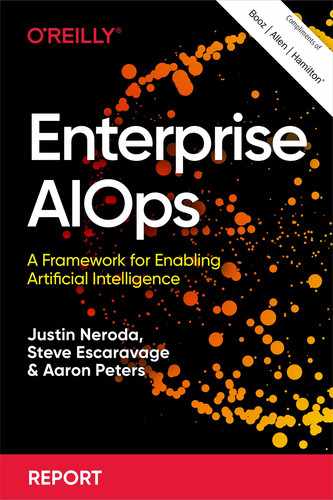Preface
A significant transformation is underway in the marketplace.
Mountains of data are being generated on a daily basis. Business operations, online transactions, vehicles and smart homes, our cell phone, and the increasing prevalence of the Internet of Things (IoT) means that data is continuously being generated and stored.
This growth in data vastly outstrips growth in the supply of technical analysts as demand for their services proliferates across industries. Companies, governments, and organizations are rightly asking how they can possibly provide value from these data volumes with their existing analytical capabilities and staff while determining where they need to invest to meet this growth.
When deployed effectively, Artificial Intelligence (AI) provides the necessary force multiplier, allowing organizations to generate insights not possible even a few years ago.1 AI provides organizations with the ability to process vast amounts of data by training algorithms to automate current processes, generate new insights, and then present these insights so that decision makers can act.
Rapid gains in computing power, inexpensive storage solutions for large volumes of data, and new research in algorithm development make AI increasingly more accessible. These three keys—processing power, data, and algorithms—bring us to a new reality, one where AI can now meet or exceed human capability across a variety of diverse tasks.
Similar to past industrial revolutions, AI’s adoption will have sweeping effects on our daily lives and work. Traditional business analytics (think Excel or basic statistical analyses) provided a historically competitive advantage to organizations in many industries. Now, companies are seeking the next wave of competitive advantage and strive for better performance in their analyses—a result that effective AI deployments can deliver. As such, artificial intelligence will change how we conduct business, introducing new efficiencies—and complexities—that we are just beginning to understand. Just as importantly, AI will fundamentally alter how you manage your teams, services, and operations.
The ability of strategic leaders to anticipate and guide these long-term changes will be essential to ensuring the success of this transition and allowing their organization to remain competitive. While there is growing consensus around AI’s importance, there is a growing chasm regarding how to successfully deploy and apply artificial intelligence at an enterprise-wide scale. Many organizations are struggling with expanding, evolving, and integrating their early AI development efforts into mature, sustainable, enterprise-wide capabilities. This gap is due to the drastic increase in scope and complexity required to operationalize artificial intelligence, particularly in terms of integrating AI solutions within the larger organization.
This report is for business leaders who desire to transition AI from small, pilot projects to an enterprise-wide reality. We will introduce an artificial intelligence operations (AIOps) engineering framework to assist you in overcoming these post-pilot challenges through responsibly developing AI tools, the important role of data management, team roles and responsibilities, and large-scale implementation. The insights and strategies we share come from the lessons we’ve learned working at Booz Allen Hamilton on a portfolio of over 120 AI projects across the federal government.
By the end of the report, you’ll learn how to unlock the incredible potential that lies within your organization’s exponentially growing data, deriving insights not available just a few years ago.
To extract the most benefit from this report, you should understand AI’s fundamentals, its purpose, and what challenges can be solved when deploying AI-based solutions. If you’d like a quick refresher or a deeper introduction to AI, our AI primer is a great place to start.2
Acknowledgments
A huge thank-you to all the individuals who collaborated with us on this report. To the following colleagues: John Larson, Kathleen Featheringham, Elizabeth Cardosa, Alex Walter-Higgins, Caleb Wharton, Sheshadri Mudiyanur, Byron Gaskin, Jeffrey Gross, Chuck Audet, Drew Farris, Drew Leety, Geoff Schaefer, Jonathan Grundy, David McCleary, Susan Johnston, Katrina Jacobs, Catherine Quinn, and Catherine Ordun—your insight and contributions strengthened this piece considerably.
1 While there are many, often competing, technical definitions for AI, we wanted to provide a broad, high-level definition for this report. Our definition of AI is extracted from the National Security Commission on Artificial Intelligence. You can view their 2021 report at their website, where they define AI on page 20.
2 Booz Allen Hamilton, The Artificial Intelligence Primer, accessed July 13, 2021.
